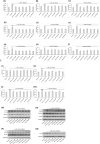Homocysteine metabolites inhibit autophagy by upregulating miR-21-5p, miR-155-5p, miR-216-5p, and miR-320c-3p in human vascular endothelial cells
- PMID: 38531978
- PMCID: PMC10966103
- DOI: 10.1038/s41598-024-57750-3
Homocysteine metabolites inhibit autophagy by upregulating miR-21-5p, miR-155-5p, miR-216-5p, and miR-320c-3p in human vascular endothelial cells
Abstract
Nutritional and genetic deficiencies in homocysteine (Hcy) metabolism lead to hyperhomocysteinemia (HHcy) and cause endothelial dysfunction, a hallmark of atherosclerosis, which is a major cause of cardiovascular disease (CVD). Impaired autophagy causes the accumulation of damaged proteins and organelles and is associated with CVD. Biochemically, HHcy is characterized by elevated levels of Hcy and its metabolites, Hcy-thiolactone and N-Hcy-protein. However, whether these metabolites can dysregulate mTOR signaling and autophagy in endothelial cells is not known. Here, we examined the influence of Hcy-thiolactone, N-Hcy-protein, and Hcy on autophagy human umbilical vein endothelial cells. We found that treatments with Hcy-thiolactone, N-Hcy-protein, or Hcy significantly downregulated beclin 1 (BECN1), autophagy-related 5 (ATG5), autophagy-related 7 (ATG7), and microtubule-associated protein 1 light chain 3 (LC3) mRNA and protein levels. We also found that these changes were mediated by upregulation by Hcy-thiolactone, N-Hcy-protein, and Hcy of autophagy-targeting microRNA (miR): miR-21, miR-155, miR-216, and miR-320c. The effects of these metabolites on levels of miR targeting autophagy as well as on the levels of BECN1, ATG5, ATG7, and LC3 mRNA and protein were abrogated by treatments with inhibitors of miR-21, miR-155, miR-216, and mir320c. Taken together, our findings show that Hcy metabolites can upregulate miR-21, miR-155, miR-216, and mir320c, which then downregulate autophagy in human endothelial cells, important for vascular homeostasis.
Keywords: Autophagy; Endothelial dysfunction; HUVEC; Homocysteine metabolites; microRNA.
© 2024. The Author(s).
Conflict of interest statement
The authors declare no competing interests.
Figures






Similar articles
-
Homocysteine metabolites impair the PHF8/H4K20me1/mTOR/autophagy pathway by upregulating the expression of histone demethylase PHF8-targeting microRNAs in human vascular endothelial cells and mice.FASEB J. 2024 Sep 30;38(18):e70072. doi: 10.1096/fj.202302116R. FASEB J. 2024. PMID: 39323294
-
Homocysteine Metabolites, Endothelial Dysfunction, and Cardiovascular Disease.Int J Mol Sci. 2025 Jan 16;26(2):746. doi: 10.3390/ijms26020746. Int J Mol Sci. 2025. PMID: 39859460 Free PMC article. Review.
-
Homocysteine thiolactone and N-homocysteinylated protein induce pro-atherogenic changes in gene expression in human vascular endothelial cells.Amino Acids. 2015 Jul;47(7):1319-39. doi: 10.1007/s00726-015-1956-7. Epub 2015 Mar 24. Amino Acids. 2015. PMID: 25802182 Free PMC article.
-
Oxymatrine Inhibits Homocysteine-Mediated Autophagy via MIF/mTOR Signaling in Human Umbilical Vein Endothelial Cells.Cell Physiol Biochem. 2018;45(5):1893-1903. doi: 10.1159/000487912. Epub 2018 Feb 28. Cell Physiol Biochem. 2018. PMID: 29510402
-
The pathophysiological hypothesis of homocysteine thiolactone-mediated vascular disease.J Physiol Pharmacol. 2008 Dec;59 Suppl 9:155-67. J Physiol Pharmacol. 2008. PMID: 19261978 Review.
Cited by
-
Exosomal miR-155-5p promote the occurrence of carotid atherosclerosis.J Cell Mol Med. 2024 Nov;28(21):e70187. doi: 10.1111/jcmm.70187. J Cell Mol Med. 2024. PMID: 39495676 Free PMC article.
-
Homocysteine Thiolactone Detoxifying Enzymes and Alzheimer's Disease.Int J Mol Sci. 2024 Jul 25;25(15):8095. doi: 10.3390/ijms25158095. Int J Mol Sci. 2024. PMID: 39125665 Free PMC article. Review.
-
Extracellular vesicles in atherosclerosis cardiovascular disease: emerging roles and mechanisms.Front Cardiovasc Med. 2025 Jun 24;12:1611557. doi: 10.3389/fcvm.2025.1611557. eCollection 2025. Front Cardiovasc Med. 2025. PMID: 40630905 Free PMC article. Review.
-
Role of hyperhomocysteinemia in atherosclerosis: from bench to bedside.Ann Med. 2025 Dec;57(1):2457527. doi: 10.1080/07853890.2025.2457527. Epub 2025 Feb 3. Ann Med. 2025. PMID: 39898976 Free PMC article. Review.
References
MeSH terms
Substances
Grants and funding
LinkOut - more resources
Full Text Sources
Research Materials
Miscellaneous

